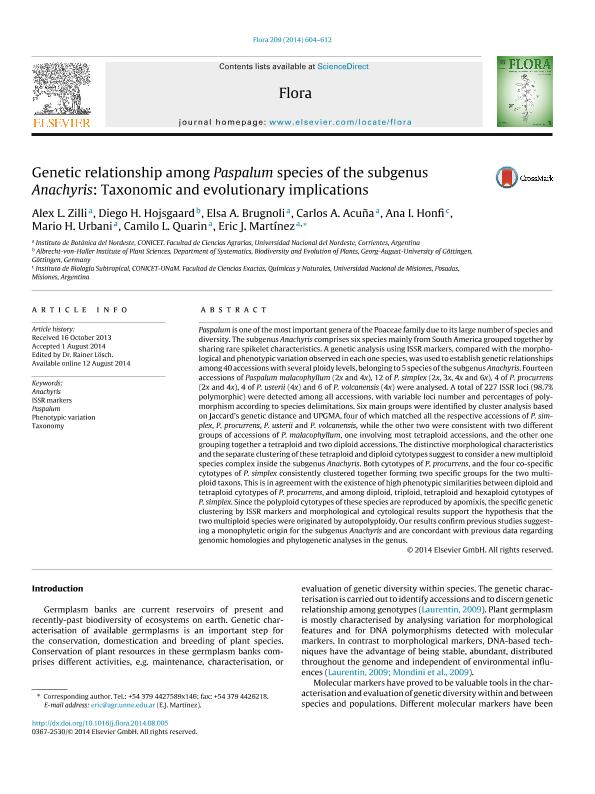Mostrar el registro sencillo del ítem
dc.contributor.author
Zilli, Alex Leonel

dc.contributor.author
Hojsgaard, Diego Hernan

dc.contributor.author
Brugnoli, Elsa Andrea

dc.contributor.author
Acuña, Carlos Alberto

dc.contributor.author
Honfi, Ana Isabel

dc.contributor.author
Urbani, Mario Hugo

dc.contributor.author
Quarin, Camilo Luis

dc.contributor.author
Martínez, Eric Javier

dc.date.available
2018-02-09T14:47:02Z
dc.date.issued
2014-08
dc.identifier.citation
Zilli, Alex Leonel; Hojsgaard, Diego Hernan; Brugnoli, Elsa Andrea; Acuña, Carlos Alberto; Honfi, Ana Isabel; et al.; Genetic relationship among Paspalum species of the subgenus Anachyris: Taxonomic and evolutionary implications; Elsevier Gmbh; Flora; 209; 8-2014; 604-612
dc.identifier.issn
0367-2530
dc.identifier.uri
http://hdl.handle.net/11336/36290
dc.description.abstract
Paspalum is one of the most important genera of the Poaceae family due to its large number of species anddiversity. The subgenus Anachyris comprises six species mainly from South America grouped together bysharing rare spikelet characteristics. A genetic analysis using ISSR markers, compared with the morpho-logical and phenotypic variation observed in each one species, was used to establish genetic relationshipsamong 40 accessions with several ploidy levels, belonging to 5 species of the subgenus Anachyris. Fourteen accessions of Paspalum malacophyllum (2x and 4x), 12 of P. simplex (2x, 3x, 4x and 6x), 4 of P. procurrens(2x and 4x), 4 of P. usterii (4x) and 6 of P. volcanensis (4x) were analysed. A total of 227 ISSR loci (98.7%polymorphic) were detected among all accessions, with variable loci number and percentages of poly-morphism according to species delimitations. Six main groups were identified by cluster analysis basedon Jaccard?s genetic distance and UPGMA, four of which matched all the respective accessions of P. sim-plex, P. procurrens, P. usterii and P. volcanensis, while the other two were consistent with two differentgroups of accessions of P. malacophyllum, one involving most tetraploid accessions, and the other onegrouping together a tetraploid and two diploid accessions. The distinctive morphological characteristicsand the separate clustering of these tetraploid and diploid cytotypes suggest to consider a new multiploidspecies complex inside the subgenus Anachyris. Both cytotypes of P. procurrens, and the four co-specificcytotypes of P. simplex consistently clustered together forming two specific groups for the two multi-ploid taxons. This is in agreement with the existence of high phenotypic similarities between diploid andtetraploid cytotypes of P. procurrens, and among diploid, triploid, tetraploid and hexaploid cytotypes of P. simplex. Since the polyploid cytotypes of these species are reproduced by apomixis, the specific genetic clustering by ISSR markers and morphological and cytological results support the hypothesis that thetwo multiploid species were originated by autopolyploidy. Our results confirm previous studies suggest-ing a monophyletic origin for the subgenus Anachyris and are concordant with previous data regardinggenomic homologies and phylogenetic analyses in the genus.
dc.format
application/pdf
dc.language.iso
eng
dc.publisher
Elsevier Gmbh

dc.rights
info:eu-repo/semantics/openAccess
dc.rights.uri
https://creativecommons.org/licenses/by-nc-sa/2.5/ar/
dc.subject
Anachyris
dc.subject
Issr Markers
dc.subject
Paspalum
dc.subject
Phenotypic Variation
dc.subject
Taxonomy
dc.subject.classification
Otras Ciencias Biológicas

dc.subject.classification
Ciencias Biológicas

dc.subject.classification
CIENCIAS NATURALES Y EXACTAS

dc.title
Genetic relationship among Paspalum species of the subgenus Anachyris: Taxonomic and evolutionary implications
dc.type
info:eu-repo/semantics/article
dc.type
info:ar-repo/semantics/artículo
dc.type
info:eu-repo/semantics/publishedVersion
dc.date.updated
2018-02-07T17:03:58Z
dc.journal.number
209
dc.journal.pagination
604-612
dc.journal.pais
Alemania

dc.description.fil
Fil: Zilli, Alex Leonel. Consejo Nacional de Investigaciones Científicas y Técnicas; Argentina. Universidad Nacional del Nordeste. Facultad de Ciencias Agrarias; Argentina
dc.description.fil
Fil: Hojsgaard, Diego Hernan. Universität Göttingen; Alemania
dc.description.fil
Fil: Brugnoli, Elsa Andrea. Universidad Nacional del Nordeste. Facultad de Ciencias Agrarias; Argentina. Consejo Nacional de Investigaciones Científicas y Técnicas; Argentina
dc.description.fil
Fil: Acuña, Carlos Alberto. Consejo Nacional de Investigaciones Científicas y Técnicas; Argentina. Universidad Nacional del Nordeste. Facultad de Ciencias Agrarias; Argentina
dc.description.fil
Fil: Honfi, Ana Isabel. Universidad Nacional de Misiones; Argentina
dc.description.fil
Fil: Urbani, Mario Hugo. Universidad Nacional del Nordeste. Facultad de Ciencias Agrarias; Argentina
dc.description.fil
Fil: Quarin, Camilo Luis. Consejo Nacional de Investigaciones Científicas y Técnicas; Argentina. Universidad Nacional del Nordeste. Facultad de Ciencias Agrarias; Argentina
dc.description.fil
Fil: Martínez, Eric Javier. Universidad Nacional del Nordeste. Facultad de Ciencias Agrarias; Argentina. Consejo Nacional de Investigaciones Científicas y Técnicas; Argentina
dc.journal.title
Flora

dc.relation.alternativeid
info:eu-repo/semantics/altIdentifier/doi/http://dx.doi.org/10.1016/j.flora.2014.08.005
dc.relation.alternativeid
info:eu-repo/semantics/altIdentifier/url/http://www.sciencedirect.com/science/journal/aip/03672530
Archivos asociados
